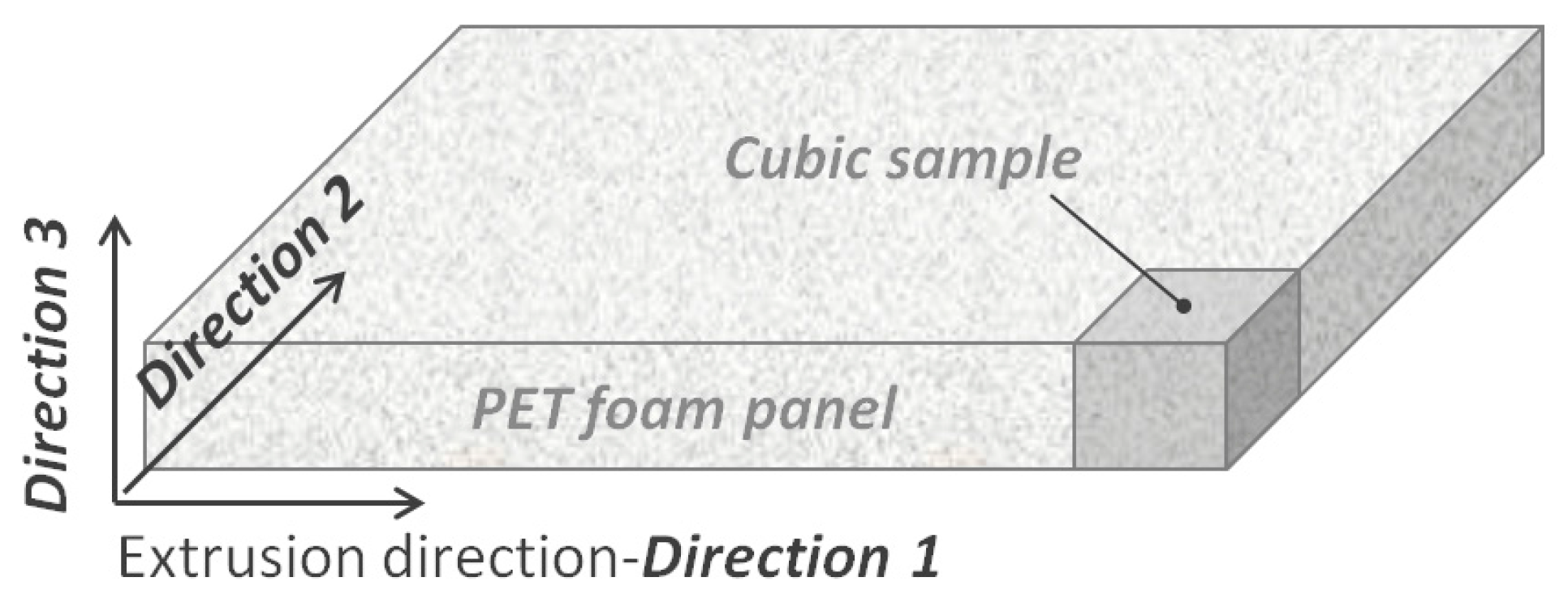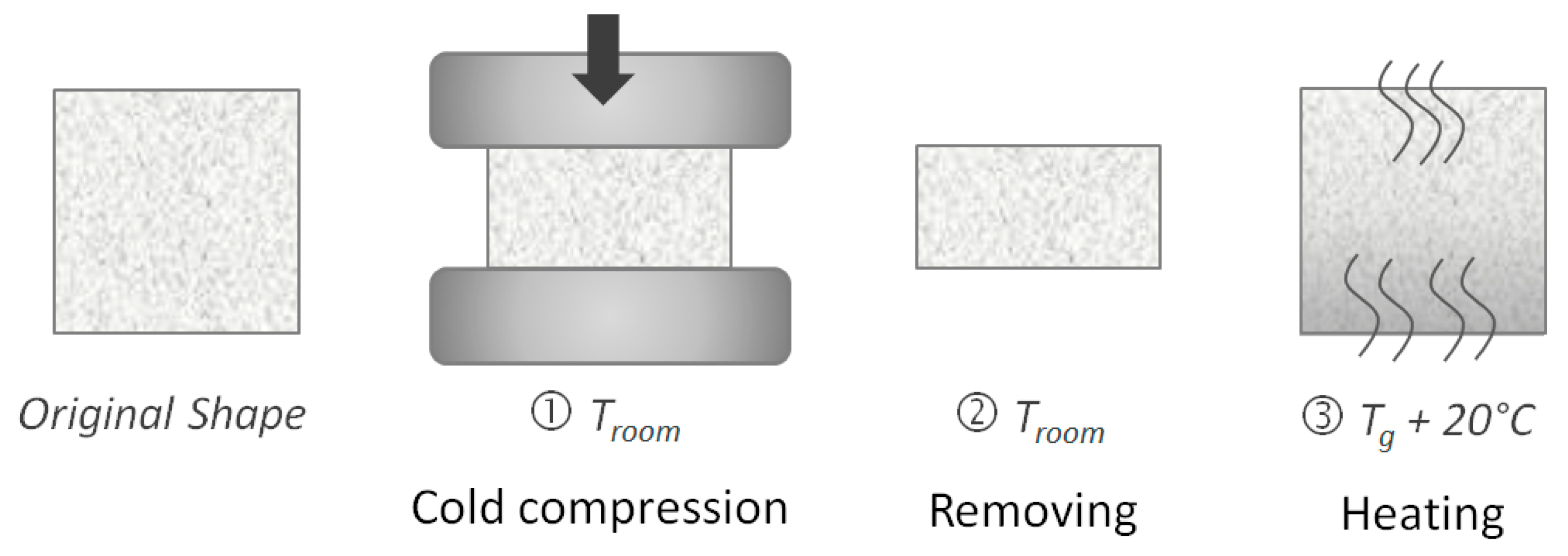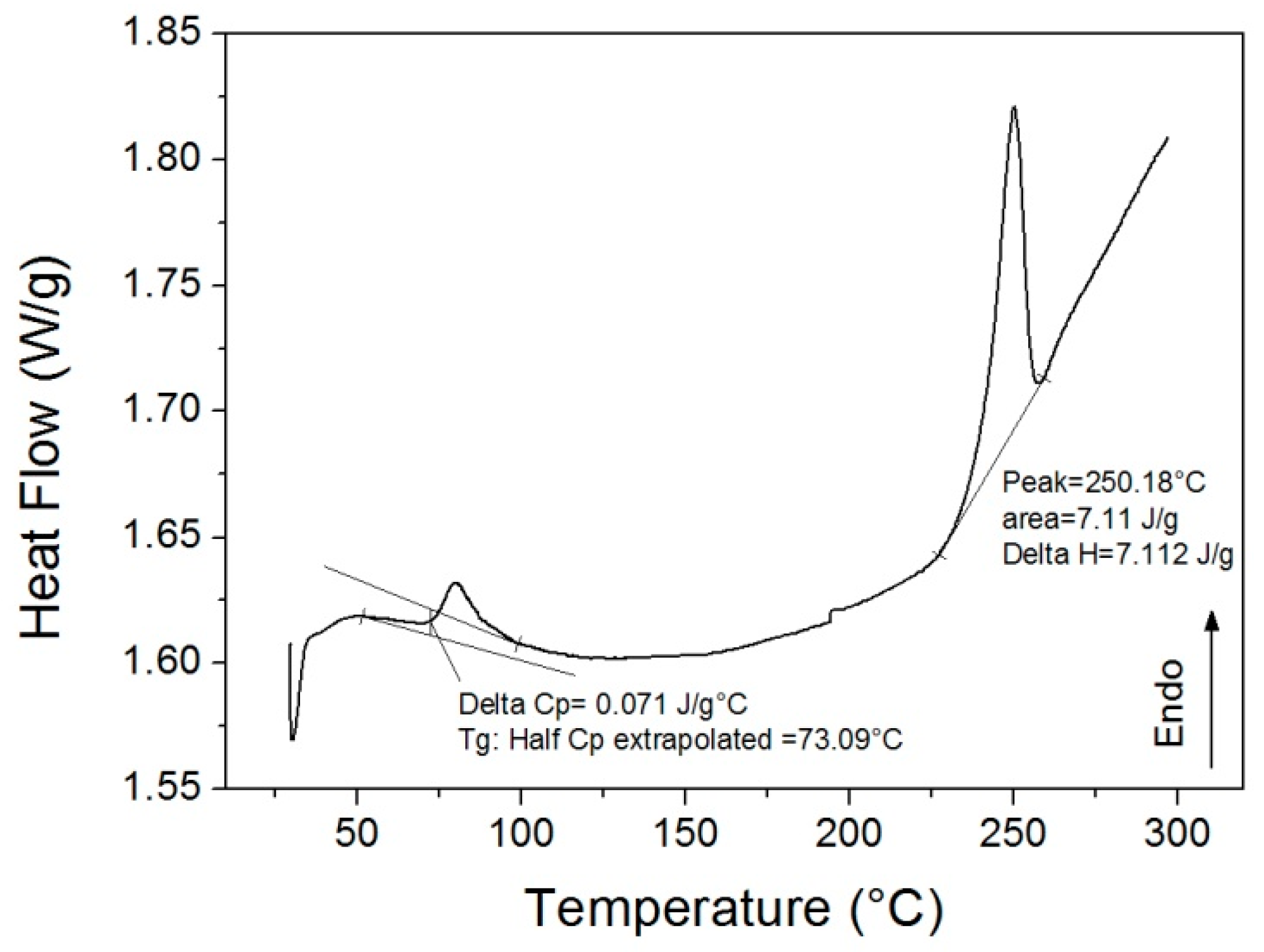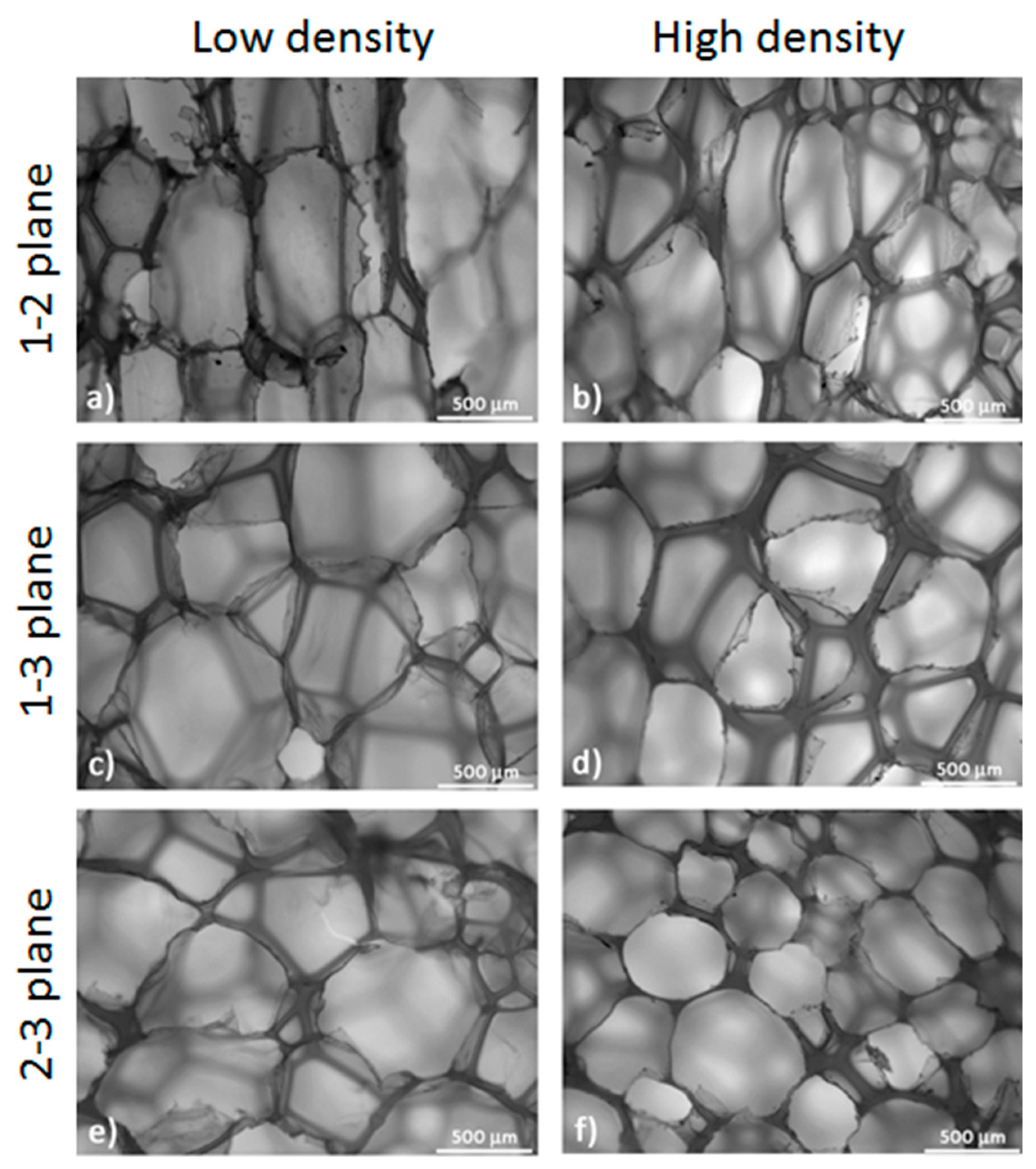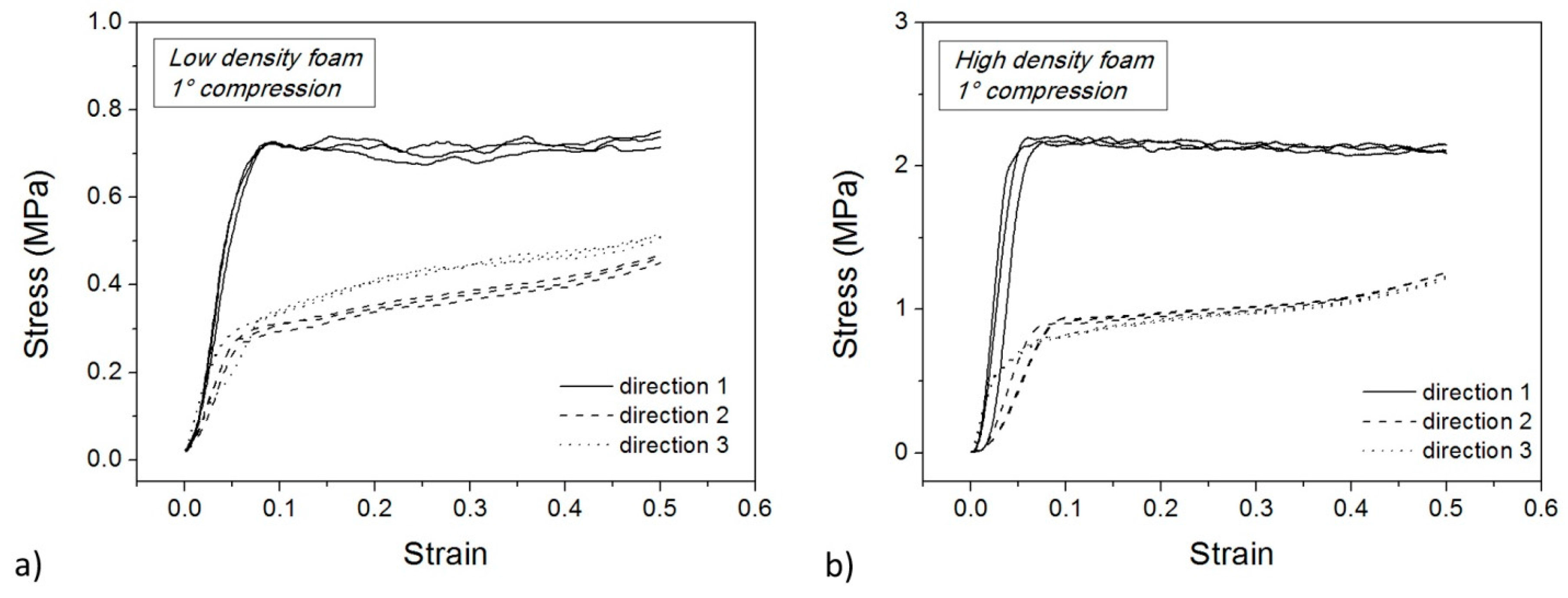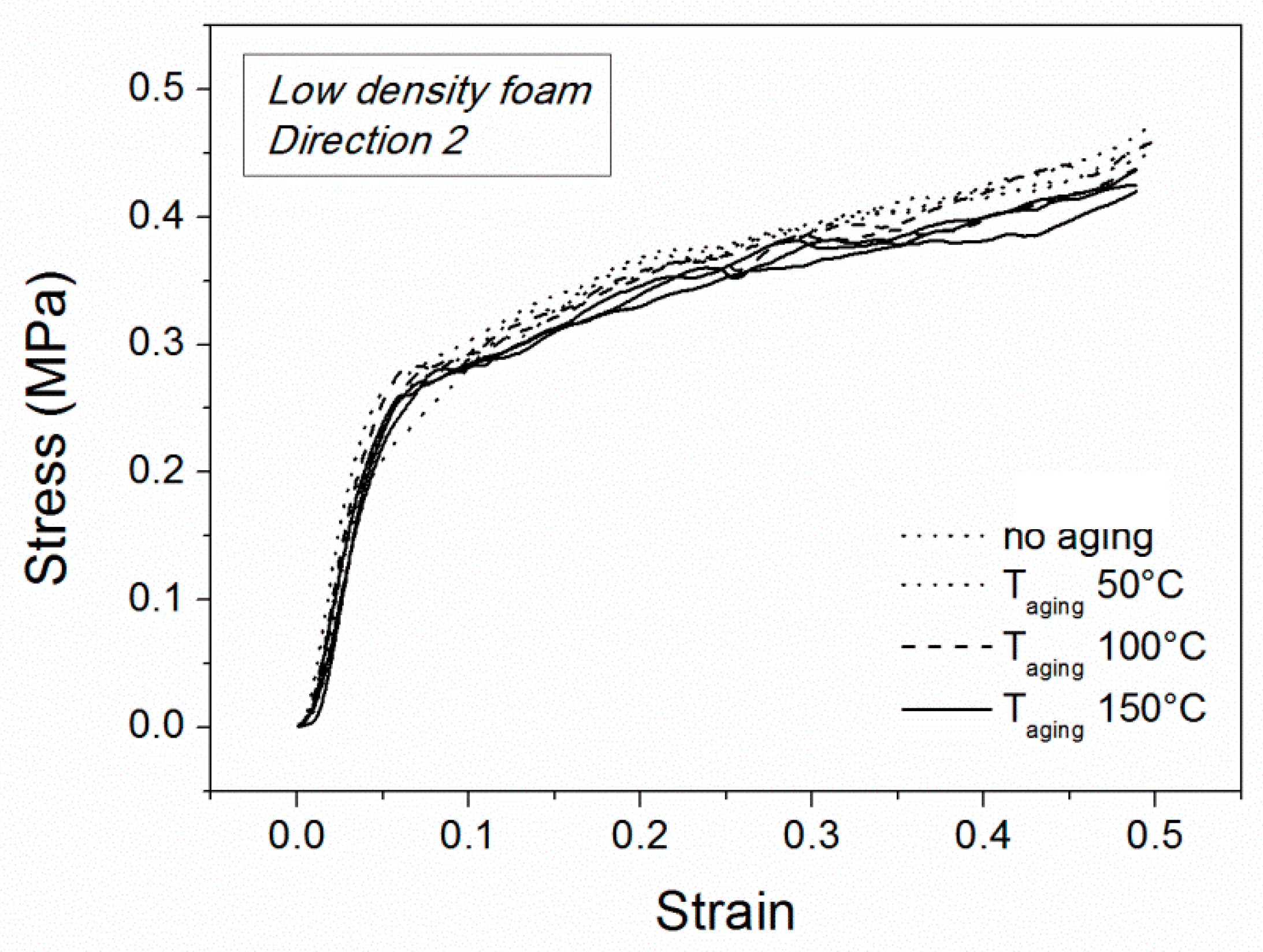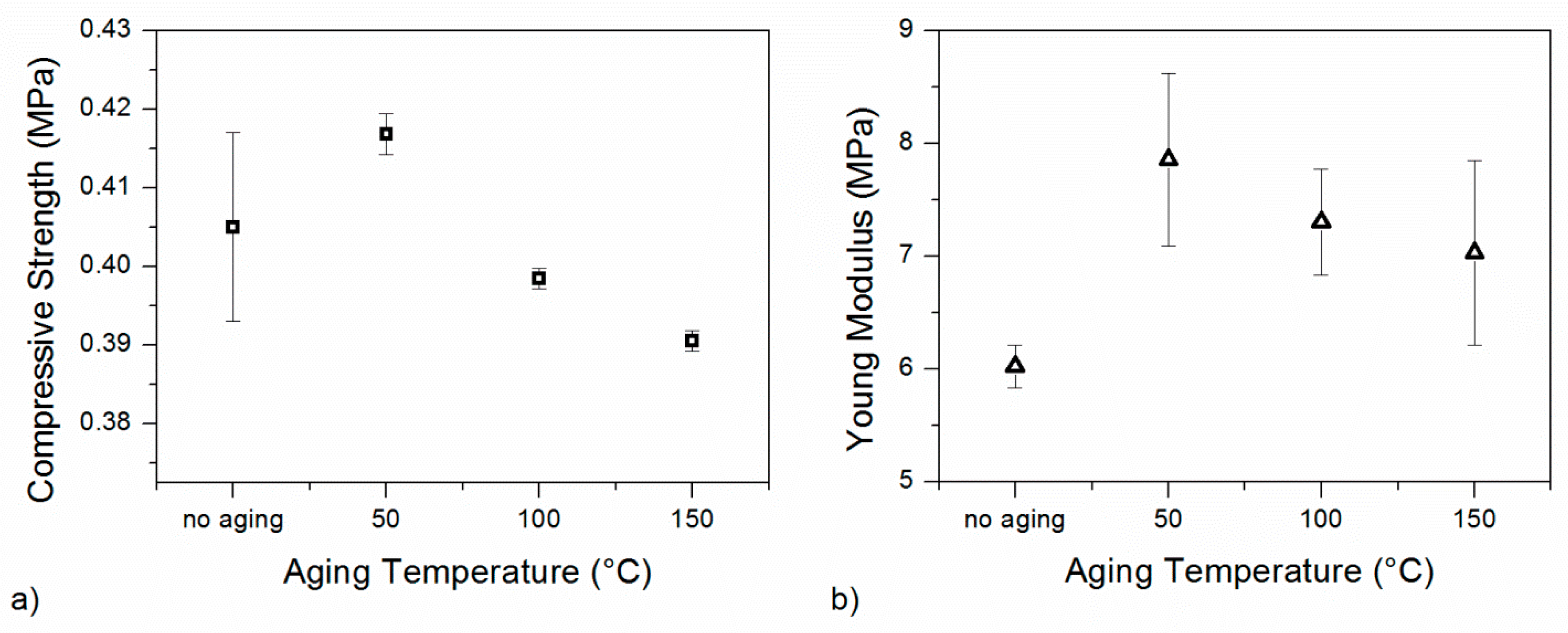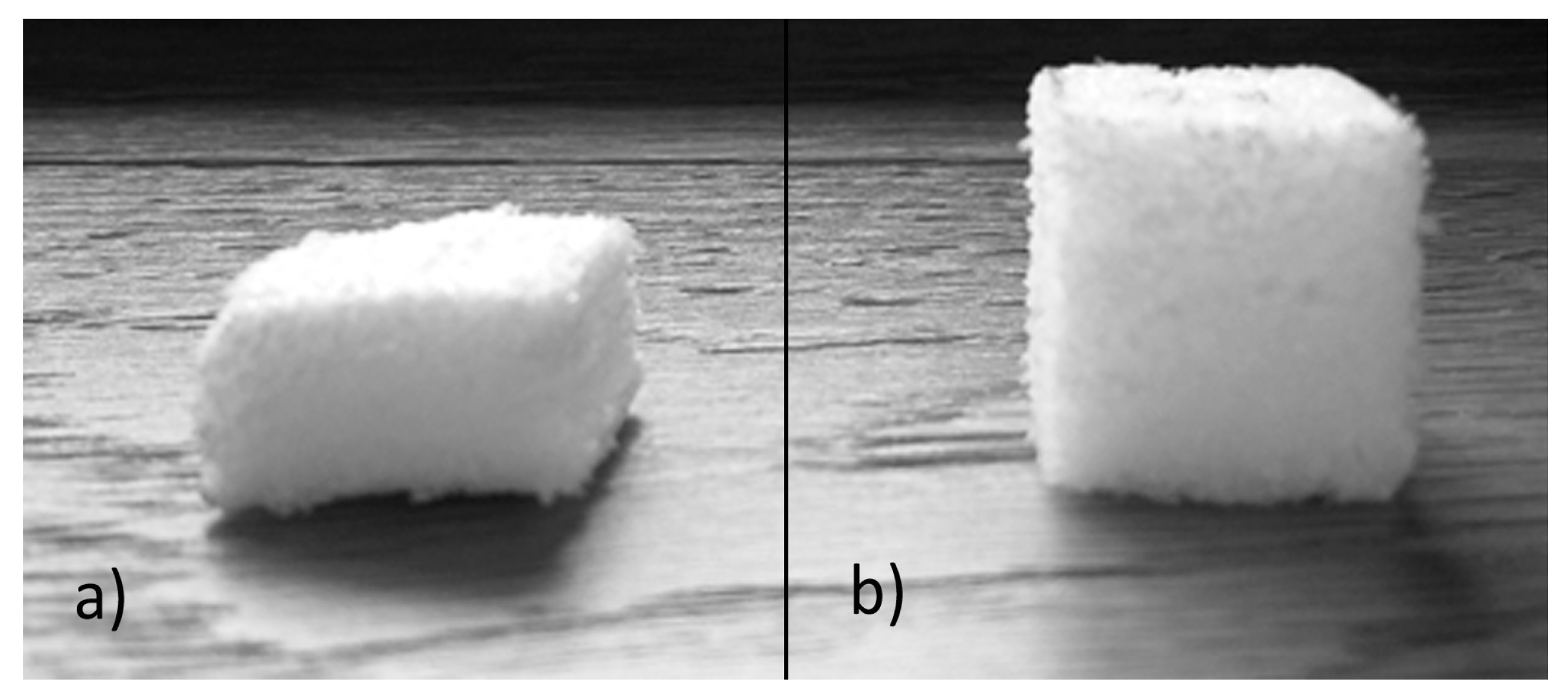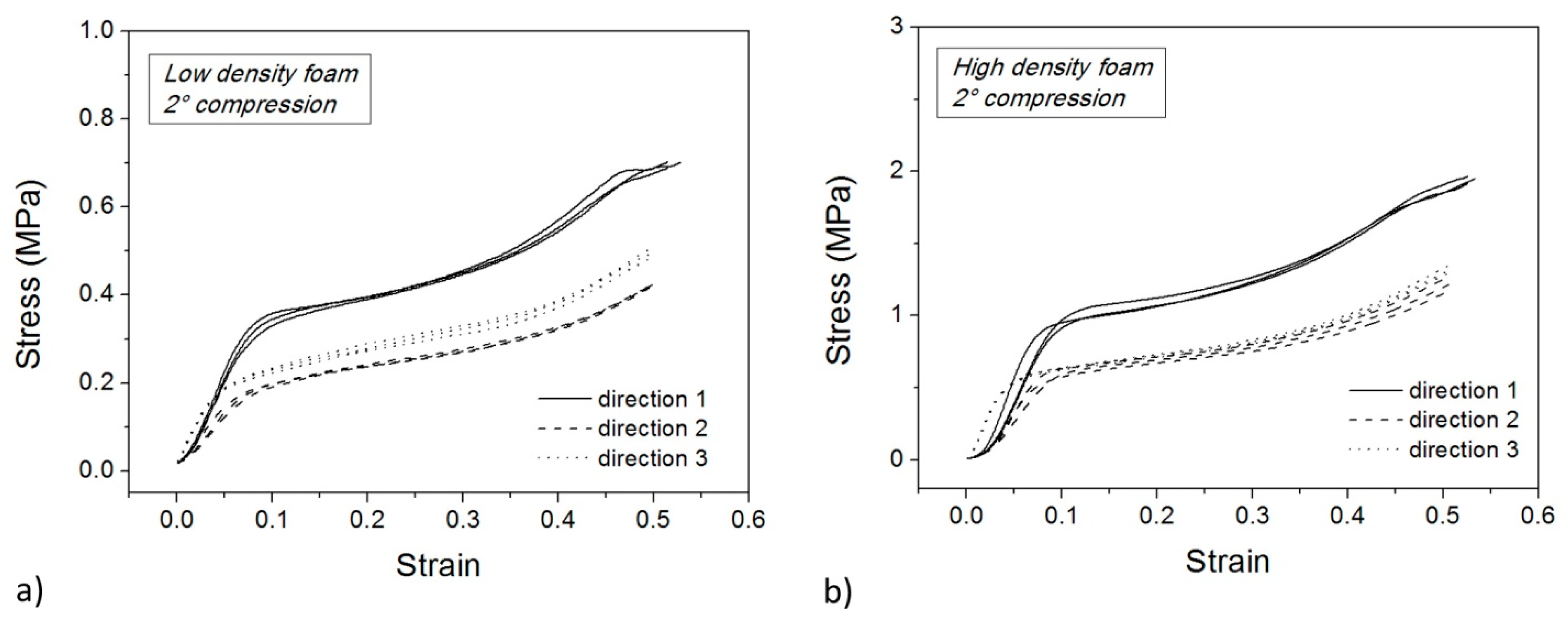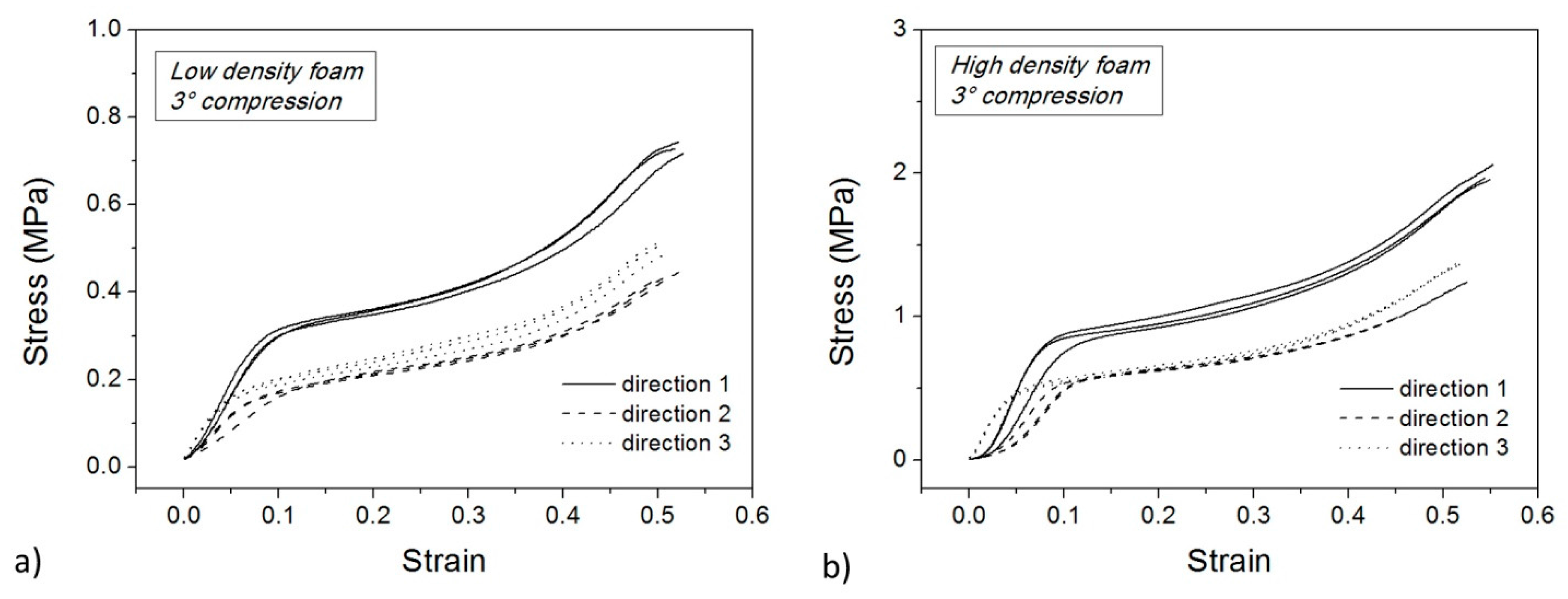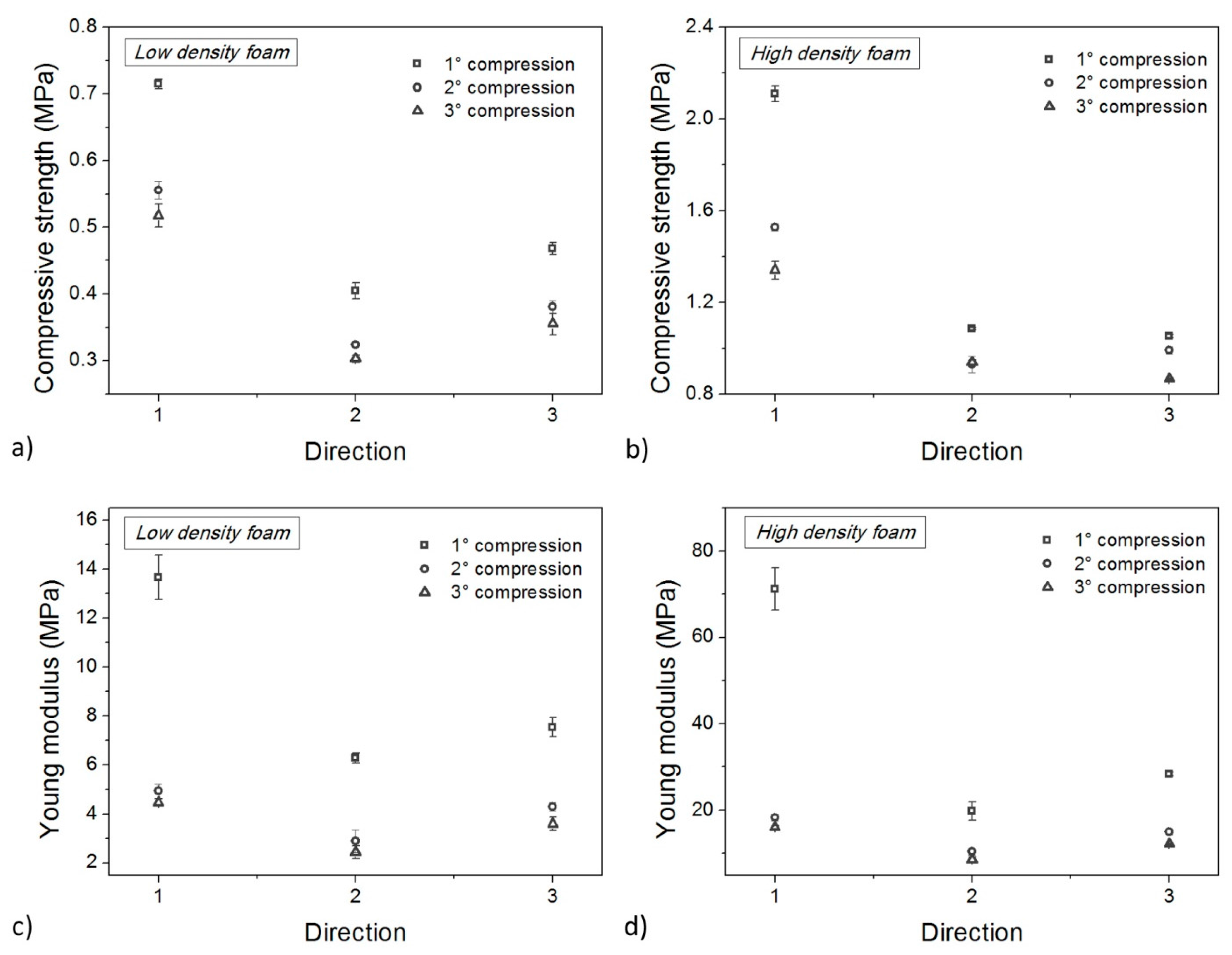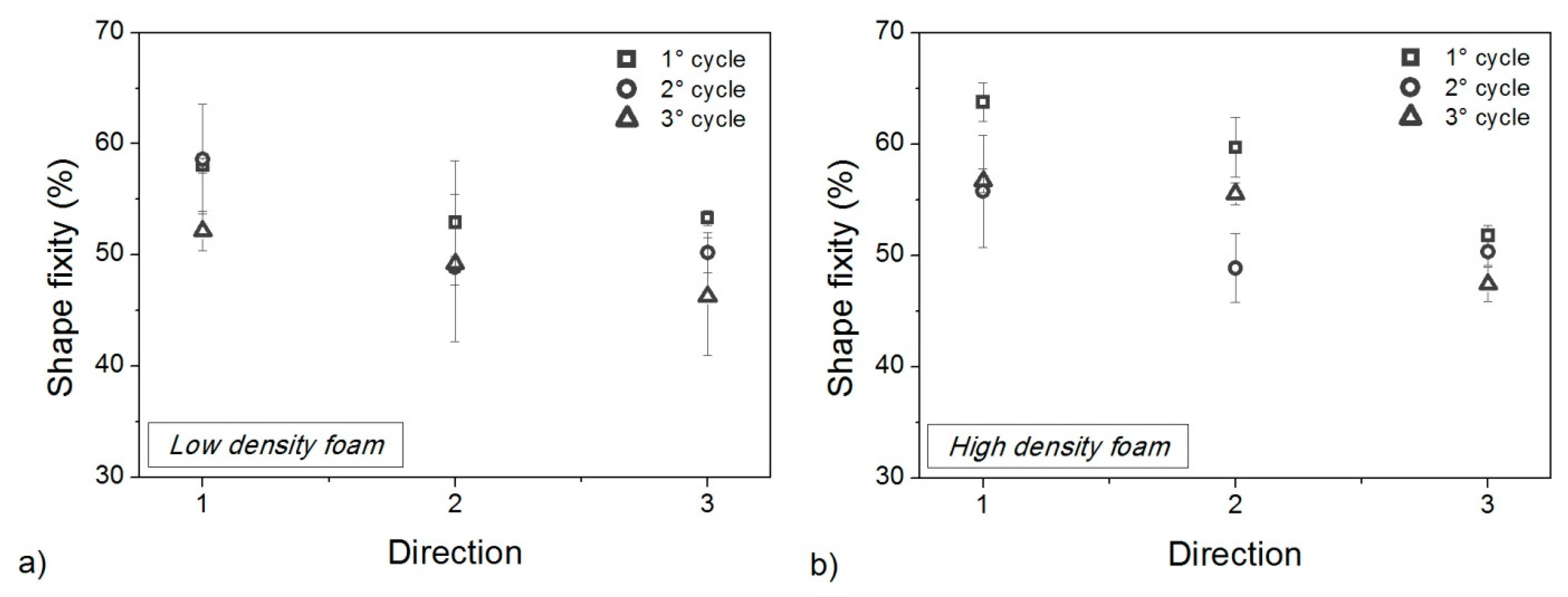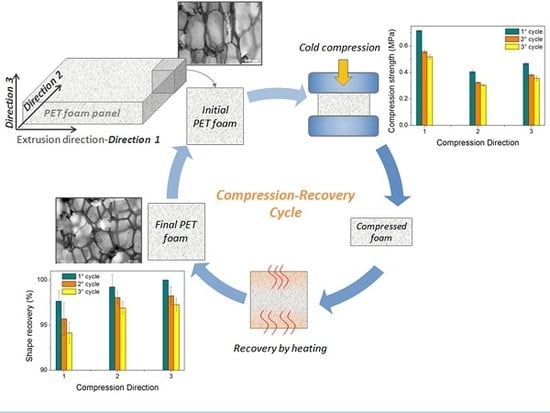Understanding the shape memory behavior of foams is a complex task because of the combination of material and structural parameters. Moreover, manufacturing processes strongly influences foam properties, homogeneity and anisotropy. Nevertheless, PET foams have shown very high SM properties also by performing cold memory steps. Typically, SMPs exhibit brittle behavior in the rigid state with very low formability. In PET foams, this peculiar behavior should depend on the combination of high material crystallinity and moderately low glass transition temperature. Crystals always behave like a rigid phase, whereas amorphous PET is partially soft at room temperature and provides structural deformability. On the other hand, molecular mobility is not enough to allow full shape recovery at room temperature. As a result, amorphous PET also allows foam cell collapsing in cold compression but it needs higher temperatures for shape recovery.
3.1. Material Transitions
By assuming a bulk density of 1.38 g/cm
3, a relative density of 5% and 8% results for the low and high-density foam. Indeed, most of the foam volume is composed of voids. This is an issue for measuring material transitions with thermal analyses.
Figure 3 shows the DSC curve of a high density sample. The
Tg evaluation is affected by the occurrence of relaxation enthalpy but a value close to 73 °C may be inferred. The occurrence of the relaxation enthalpy peak is in agreement with the expected SM behavior as the polymer is able to freeze stresses into the structure. Moreover, that is also evidence of the strong influence of the manufacturing process on the material status. The estimated value of 73 °C for
Tg is in agreement with the expected datum for this kind of resin. A melting peak is also visible in the DSC scan even if its shape and size is probably affected by low sample mass, and foam collapse into the crucible during melting. Nevertheless, a recrystallization peak, before the melting peak, seems to be absent even though it is typical for PET products. It is possible to deduce that the foam itself is close to its maximum crystallinity. After foam extrusion, the panel cooling rate is low because of the very limited thermal diffusivity, and amorphous PET is minimized.
DMA tests confirm the data from DSC, as shown in
Figure 4. By considering the peak temperature of the loss factor (tan δ) in correspondence with the inflection point of the storage modulus (E’), a
Tg value of 84 °C results for the low-density foam, and 89 °C for the high-density foam. The glass transition is in the same range of the DSC curve but the extracted value is higher because of a small thermal lag. The peak of the loss modulus (E’’) is closer to the DSC value. Unfortunately, results are partially affected by sample collapse under load during heating, as shown by the storage modulus increase before the glass transition. This occurrence could be responsible for the differences in measured
Tg of the low and high-density foam as well as between the DSC and DMA results, even if a perfect superposition is very rare. Nevertheless, the effect of molecular mobility during heating is evident despite the high crystallinity level. The storage modulus of the foam shows a sudden decrease after
Tg even if the melting temperature is far away (250 °C,
Figure 3). Also, differences in foam stiffness for the two densities are clear. At 30 °C the storage modulus is 3.7 MPa for the low-density foam, and 6.5 MPa the for high-density foam. However, this difference in the glassy state is completely overcome in the rubbery state (over 150 °C) where foams behave in the same way.
3.2. Morphology and Mechanical Properties
Micrographs of the two different foams along the three principal directions are shown in
Figure 5. The foam structure is closed-cell with an average cell size of 0.54 mm for the high-density foam, and 0.73 mm for the low-density foam. However, the measured cell size is not uniform along all the foam directions. In the 1-2 plane, the average cell size is 0.7 and 0.98 mm, respectively, in the 2-3 plane the average cell size is 0.42 and 0.55 mm, respectively, and in the 1-3 plane, the average cell size is 0.45 and 0.59 mm, respectively. According to these observations, foam cells were mainly elongated along Direction 1 (the extrusion direction) and that is apparent from the comparison between plane 1-2 and 2-3. Cell sizes in plane 2-3 and 1-3 are comparable even if a small increase is present in the latter. A further comparison can be made in terms of the geometrical ratio of the cells along the three principal planes as reported in
Table 1. For both foams, the geometrical ratio maximum is in the 1-2 plane, as qualitatively confirmed by
Figure 5a,b. Between foams, the cell ratio is higher for the low density sample, where a value of 2.25 is reached. A high geometrical ratio is also present in the 1-3 plane but in this case the maximum value (1.52) is achieved by the high-density foam. However, no anisotropy is observable in the 2-3 plane for both foams. The presence of anisotropy in both the 1-2 and 1-3 planes suggests that cell elongation is not perfectly aligned with the extrusion direction.
Microstructural observations reveal the strong anisotropy of PET foams. It is expected that mechanical and functional performances are affected by this anisotropy. The foam response to external loads depends on the direction of the applied forces, and
Figure 6a,b show the compressive stress-strain curves along the three principal directions. These tests correspond to the first loading stage of the memory-recovery cycle. Three samples are shown for each direction. Tests along the same direction are almost perfectly superimposed so as to show the good homogeneity of the initial foam panels.
The effect of the sample orientation is evident. Higher rigidity and higher strength are measured along Direction 1 (the extrusion direction) whereas similar performances are measured in the other two directions (along the panel width and thickness). Along Direction 1, a compressive strength can also be extracted for both foams as the plateau value of the stress. Along the other two directions, a plateau is not visible. Instead, two linear stages are present with different slope. In these cases, a compressive strength can be extracted as the maximum stress (i.e., the stress at 50% strain). Foam densification is not visible along Direction 1 whereas it seems to start after the second linear stage in the other two directions. Higher cell sizes lead to higher material deformability whereas molecular orientation is responsible for stiffness and strength. A difference is appreciable between the width and thickness direction only for the low-density foam because of the high cell size.
In order to quantify this difference in mechanical properties, the Young’s modulus (E
c) was estimated from the slope of the initial linear stages, even if non-elastic contributes could be superimposed as well. The maximum stress reached at 50% of the strain was taken as the foam strength (σ
S). These values are reported in
Table 2 in terms of average and dispersion of measured data. The compressive modulus (E
c) in the extrusion direction is approximately 2 times that in the transverse direction for low density samples. The foam strength in the extrusion direction is approximately twice that of the other two directions as well. Data for the high-density foam are higher but mechanical anisotropy seems to be similar, a part from a lower uniformity in the transverse plane. For example, in the low-density foam, the mean compressive modulus in Direction 3 is 12% higher than in Direction 2. This difference increases up to 42% for the high-density foam. Data for strength are not perfectly aligned due to the occurrence of foam densification during testing. By using the compressive modulus for the evaluation of an anisotropy ratio, a value of 2.1 results along the extrusion direction for the low-density foam, with a result of 2.4 for the high-density foam. These anisotropy ratios are very close to the geometrical ratios of the cells of
Table 1. By considering the compressive strength, the anisotropy ratio decreases down to 1.6 and 2.0, respectively.
3.4. Shape Memory Properties
The shape memory properties of PET foams were tested by means of multiple thermo-mechanical cycles. Sample pre-conditioning was omitted because of the negligible effect of the aging conditions.
Figure 9 shows a typical foam sample after the memory step which creates a non-equilibrium shape,
Figure 9a, and after the recovery step,
Figure 9b. The recovery step was performed in a muffle at 100 °C for a total period of 80 min; this time was necessary to complete the recovery phase due to the high porosity of the PET foams. Three samples for each foam and direction were tested in three consecutive memory-recovery cycles for a total of 54 compression tests. Compressive strength and elastic modulus were extracted from each compression curve whereas shape fixity and shape recovery were calculated before each thermo-mechanical cycle according to Equations (2) and (3) respectively. Because of the huge amount of data, it is important to discuss one aspect at a time.
Table 3 reports shape fixity and shape recovery at the end of the first thermo-mechanical cycle. Shape fixity is always far from 100% because of large strain recovery at the end of the compression step. Material rigidity plays an important role in this mismatch as the highest shape fixity was achieved by the high-density foam which was stiffer. Moreover, for the same foam, higher values were found along the extrusion direction (Direction 1) which was stiffer than both the transverse directions. In fact, the high-density foam in the extrusion direction shows shape fixity of 64%. This value decreases to 52% in the thickness direction (Direction 3), and to 53% in the transverse directions of the low-density foam. Nevertheless, for both foams, low values of shape fixity depend on the elastic strains recovered at the end of the memory step, whereas plastic strains seem to be negligible. This fact is confirmed by the high values of shape recovery, which is always higher than 97% for the low-density foam, and 92% for the high-density foam. Higher shape recovery was achieved in the low-density foam because of the initial lower shape fixity. A small contribution of plastic strain is present, mainly in the extrusion direction of the high-density foam. Being softer, the low-density foam immediately relaxes a part of the applied strain and can also achieve 100% shape recovery along Direction 3. The data in
Table 3 confirms that material anisotropy leads to an anisotropic shape memory behavior. Certainly, this anisotropic behavior is more evident for the high-density foam than for the low-density foam for which the shape recovery variability along the three directions is very low. Cell orientation plays a positive role in terms of shape fixity but a negative role in terms of recovery strain. Nevertheless, in comparison with other SMPs, PET foams exhibit excellent properties. In fact, these values for shape fixity and shape recovery were obtained with a cold memory step, while typical testing of other SMPs apply the memory step after heating.
In applying multiple thermo-mechanical cycles, material and microstructural changes can be expected in the foam because of the combination of heat and stresses. Pre-conditioning tests have shown that material effects only related to thermal aging should be negligible. However, a lot of energy is dissipated into the foam during mechanical loading and this energy can lead to positive or negative effects.
Figure 10 and
Figure 11 show the compression step of the second and third thermo-mechanical cycle, respectively, for the low density (a) and high density (b) foam. These curves are similar to those of the first compression test (
Figure 6) apart from the occurrence of a more pronounced densification stage at high strain. Also, the stress plateau disappears along Direction 1. In particular, the main differences in compression in Direction 1 are strongly related to the mechanical damage during the first cold compression step.
The compressive strength and elastic modulus can also be extracted from the following two compression stages to make a comparison with values from the first stage. Data are reported in
Figure 12, which shows that both properties decrease during cycling. For each density, the biggest drop is measured between the first and the second cycle and along the extrusion direction. The loss of properties is also strong in the transverse directions between the first two cycles. Comparing the second and third cycle, a small drop is always present, but not as significant as the previous one. However, in all cases, the effect of panel orientation is stronger than the effect of thermo-mechanical cycling. From this point of view, the first cycle could be seen as a “training cycle” which partially reduces material anisotropies. Nevertheless, mechanical performances at the end of this training cycle are reduced, and continue to minimally diminish in following cycles.
From a quantitative point of view, between the first two cycles, compressive strength along Direction 1 underwent a reduction of about 42% and 48% for low- and high-density foams respectively. Subsequently, between the second and the third cycle, a further reduction of 12% and 14% occurred. Along the same direction, the elastic modulus underwent an even more severe reduction between the first two cycles (64% for low-density foam and 67% for high-density foam) whereas the effect of the third cycle was almost negligible.
The effect of foam anisotropy on mechanical performances is very strong and is not erased by thermo-mechanical cycling. It is questionable if a comparable effect is also present for shape memory properties in terms of shape fixity (
Figure 13) and shape recovery (
Figure 14). According to the static properties (
Figure 12), shape fixity and shape recovery are reduced due to thermo-mechanical cycles but the changes are smaller. Dramatic drops, as seen with the compressive strength and elastic modulus, were never observed for
Rf and
Rr. Foams always preserve good shape memory behavior, and the maximum reduction of
Rf after all the cycles, is never higher than 10% (3% for
Rr).
The important role of the panel orientation is confirmed and is never lost due to cycling, although it is not comparable to the static data. Shape fixity in Direction 1 of both foams after the third thermo-mechanical cycle is comparable with Direction 2. Multiple cycles affect mainly material stiffness and strength rather than shape memory properties, and the static properties depend mainly on these characteristics. This can be explained by the fact that static performances depend mainly on the rigid part of the foam material, the PET crystals, which are altered by cyclic loading. In principle, fragmentation of crystallites, alteration of the orientation or a fragmentation of chains in initially pre-oriented asymmetric pore structure (in Direction 1), or the onset/alteration of pore wall buckling/pore wall breaking may be possible contributors to the shifting of the mechanical properties during the first and subsequent cold deformation cycles. Further experiments in this direction may contribute to an improved overall understanding of the observed data. However, shape memory behavior depends on the soft part of the foam material, amorphous PET, which is almost unaltered after thermo-mechanical cycling. Therefore, cell structure and morphology can be affected by cycles but not their ability to store a new shape and to recover the previous one.
In order to confirm the correlation between foam structure and measured performances, microscopic observations were repeated at the end of each thermo-mechanical cycle. Results are shown in
Figure 15 and
Figure 16 for low- and high-density foam, respectively. The Figures show that many broken cells and warped cell walls appear during cycling. Because of this damage, it was not possible to estimate the geometrical ratio of cells, as was possible for un-cycled samples. The presence of these ruptures highlights that the sharp reduction of static mechanical properties of low and high density PET foams could be affected by such events. Applied memory-recovery cycles are very severe due to the cold compression step. For this reason, material damage is associated with thermo-mechanical cycles. This damage is not able to erase foam anisotropy, but stiffness and strength are reduced. Nevertheless, despite the cellular materials being partially damaged, their shape memory properties are preserved and sufficient to guarantee a shape recovery of about 90% after three thermo-mechanical cycles.
